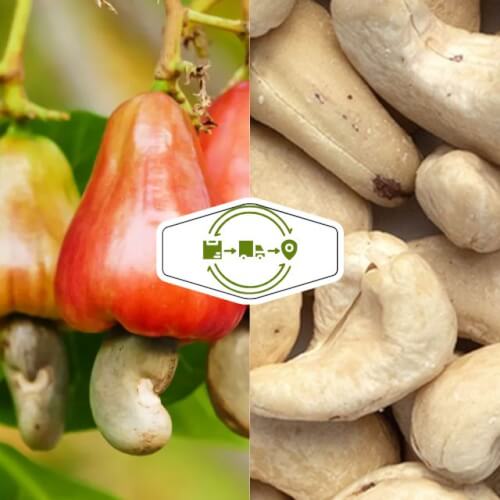
The Cashew Nut Supply Chain: Key Players and Insights
Cashew nuts, prized for their taste and nutritional value, are among the most traded nuts globally. However, the journey of a cashew nut from farm to consumer is complex, involving multiple stages and key players. Understanding this supply chain reveals the intricate web of activities and challenges that define this lucrative industry.
This article provides a detailed overview of the cashew nut supply chain, focusing on its main stages, key players, regions, challenges, and emerging solutions.
Overview of the Cashew Nut Supply Chain
The cashew nut supply chain encompasses several interlinked stages, from farming and processing to retail distribution. The chain is shaped by a diverse set of actors, including smallholder farmers, processors, exporters, and distributors, operating across various countries and regions. The industry's complexity is amplified by its global nature, with production concentrated in tropical climates and consumption driven by developed markets.
Cashew nuts undergo a labor-intensive journey requiring meticulous handling at every stage to ensure quality, traceability, and sustainability. Below, we explore the crucial steps and the stakeholders involved in bringing cashew nuts to market.
Key Stages in the Cashew Nut Supply Chain
1. Cultivation and Harvesting
Cashew trees thrive in tropical climates, and their nuts are primarily cultivated in countries such as Côte d'Ivoire, India, and Vietnam. Farmers, often smallholders, play a pivotal role in this stage.
-
Growing Conditions: Cashew trees require well-drained soils and a consistent climate.
-
Harvesting: Once the nuts mature, they are handpicked along with the attached cashew apple. This labor-intensive process demands careful handling to preserve the quality of the nuts.
2. Processing and Packaging
Raw cashew nuts are transported to processing facilities, where they undergo several stages of preparation:
-
Drying: The nuts are sun-dried to reduce moisture and extend shelf life.
-
Shelling: Removing the hard outer shell is a delicate task, often carried out manually in many regions.
-
Peeling and Grading: The inner skin is peeled, and the nuts are graded based on size and quality.
Processed nuts are then packaged to ensure freshness during transportation.
3. Transport and Distribution
Transporting cashew nuts involves two primary phases:
-
Exportation of Raw Nuts: Many countries, particularly in Africa, export raw cashews to processing hubs like Vietnam and India.
-
Distribution of Processed Nuts: Processed cashews are shipped to international markets, including Europe, the USA, and the Middle East.
4. Marketing and Retail
The final stage sees cashew nuts reaching consumers through various channels:
-
Retail: Supermarkets, health stores, and online platforms dominate the retail segment.
-
Wholesale: Bulk buyers procure cashews for use in food manufacturing or large-scale distribution.
Read more about sustainable agricultural practices in cashew cultivation.
Major Players and Regions in the Supply Chain
Key Producing Countries
-
Côte d'Ivoire: The world's largest producer, contributing over 40% of global raw cashew nut production.
-
India: A major producer and processor with an extensive domestic market for cashews.
-
Vietnam: Known for its advanced processing capabilities and significant export market.
-
Other Countries: Nigeria, Benin, and Togo are also vital contributors to global production.
Main Export Markets
Processed cashew nuts are exported to high-demand regions such as:
-
Europe: Germany and the Netherlands are significant importers.
-
North America: The USA is a top consumer of cashews, driven by their health benefits.
-
Asia: Growing demand in countries like China and Japan boosts global trade.
Explore cashew production statistics by country here.
Challenges and Issues in the Cashew Nut Supply Chain
1. Sustainability and Farming Practices
Unsustainable agricultural practices can lead to soil degradation, deforestation, and biodiversity loss. Farmers face challenges in accessing training and resources to adopt environmentally friendly techniques.
2. Transparency and Traceability
Consumers increasingly demand transparency in food sourcing. Ensuring traceability across a fragmented supply chain is challenging, especially when dealing with multiple intermediaries.
3. Logistics and Cost Inefficiencies
High transportation costs and inefficiencies in logistics affect profitability. Delays in shipping raw nuts to processing centers often result in quality deterioration.
Learn about environmental challenges in the food industry.
Solutions and Innovations in the Supply Chain
1. Technology for Improved Traceability
Adopting technologies like blockchain and IoT devices can enhance traceability and accountability. For example:
-
Blockchain: Records every step of the supply chain, offering a transparent and tamper-proof record.
-
IoT Sensors: Monitor storage conditions during transportation to ensure quality preservation.
2. Sustainable Business Models
To address environmental and social concerns, the industry is shifting toward sustainable and fair-trade models. This includes:
-
Supporting farmers with training and resources for organic cultivation.
-
Implementing fair wages and ethical labor practices.
3. Improved Logistics and Collaboration
Streamlining logistics through better coordination among stakeholders can reduce costs and enhance efficiency. Collaborative platforms help connect farmers, processors, and buyers directly.
Discover tools for logistics and traceability here.
Conclusion: Future Trends in the Cashew Nut Supply Chain
The cashew nut supply chain is an intricate network shaped by diverse players and regions. While challenges such as sustainability and transparency persist, innovative solutions are paving the way for a more efficient and ethical industry.
As consumer preferences shift toward sustainability and quality, stakeholders across the supply chain must adapt to meet these demands. By leveraging technology and fostering collaboration, the cashew nut industry can continue to thrive while addressing its environmental and social impacts.
